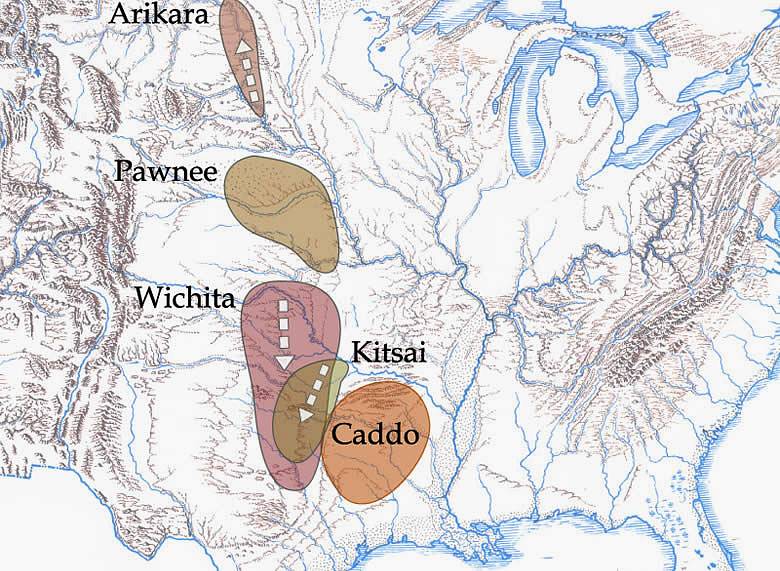|
Within the main Caddo Homeland, the
cultural continuity is unbroken from prehistory to early
history and the link to today's Caddo Nation of Oklahoma
is unquestioned.
|
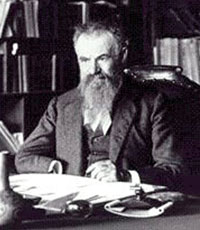
Ethnologist and famed explorer John
Wesley Powell formally defined the Caddoan language
family in 1891. Courtesy Smithsonian Institution.
|
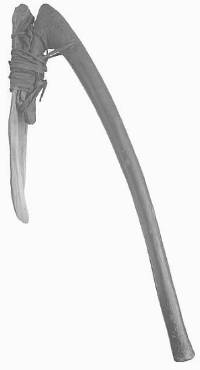
Arikara bison-scapula hoe. This type
of tool was used in farming by main Plains groups. Smithsonian
Institution National Anthropological Archives. Click
to enlarge.
|
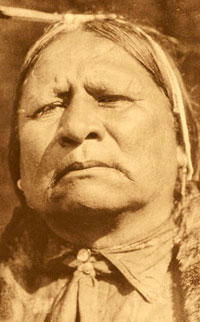
Walter Ross, a Wichita, ca. 1927.
Photograph by Edward S. Curtis, The North American
Indian, Volume 19.
|
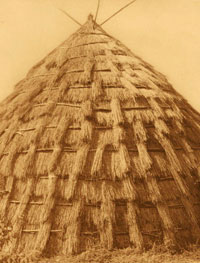
Wichita grass house, ca. 1927. Photograph
by Edward S. Curtis, The North American Indian,
Volume 19.
|
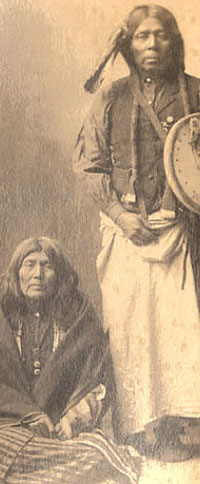
"Nasutoeas, Kichai Woman, Akahedik
(Wichita)," ca. 1898. Photograph by F. A. Rinehart,
courtesy Omaha Public Library. The Kitsai (Kichai) are
the least known of the Caddoan language groups. The
Kitsai tribe no longer exists as a separate entity;
surviving members joined the Wichita in the mid-1800s.
|
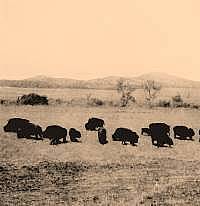
Small protected buffalo herd grazing
near Wichita Mountains, southwest Oklahoma, 1908.
|
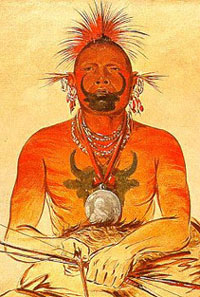
"Buffalo Bull: A Grand Pawnee
Warrior," by George Catlin, 1832. The Pawnee relied
heavily on buffalo and, in early historic times, lived
in what is today Nebraska.
|
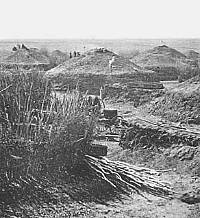
Pawnee earth lodges and corral, Nebraska
Loup Fork Village, late 19th century. Smithsonian Institution
National Anthropological Archive.
|
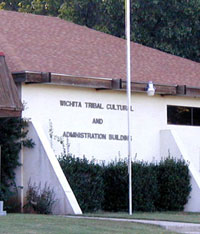
Wichita Tribal center near Anadarko,
Oklahoma. Photo by Steve Black.
|
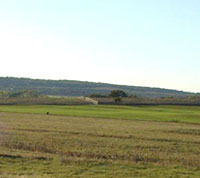
The rolling prairie in west-central
Oklahoma where the Wichita and Caddo tribes in the 1860s
were at last given small territories and allowed to
settle in peace. Photo by Steve Black.
|
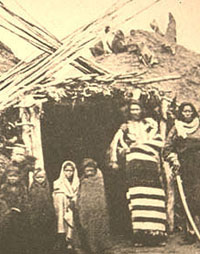
Pawnee village, ca. 1875. In the
background are two massive earth lodges. Photograph
by William H. Jackson. The northernmost Caddoan groups,
the Pawnee and their close relatives the Arikara, lived
in earth lodges to survive the brutal winters of the
Central and Northern Plains.
|
|
The Caddoan languages are Caddo, Wichita, Pawnee,
Arikara, and Kitsai, the latter four making up the Northern
Caddoan languages. The speakers of the Northern Caddoan languages
are also referred to as the Plains Caddoans because all four
tribes (and their various bands) lived in the Southern and
Central Plains during historic times. Caddo is the only Southern
Caddoan language.
"Caddo" vs. "Caddoan"
The words "Caddo" and "Caddoan"
have been used to mean different things by different researchers
and writers, adding considerable confusion to the complex
and often impossible task of understanding the relationships
among historic tribes and their ancestors. In the Tejas exhibits
we have tried to use these terms consistently.
In historical documents the word Caddo
is sometimes used to refer just to the Cadohadacho, but today
it is more commonly applied to all of the Caddo-speaking groups.
Although there was not a united Caddo Tribe until 1874 when,
under pressure from the U.S. government, the remnants of the
groups speaking various dialects of the Caddo language formally
joined together for survival, the term Caddo is still very
useful to refer to (1) the united Caddo Tribe; (2) all of
the groups known to have spoken Caddo dialects before 1859;
(3) the Caddo language; and (4) the direct ancestors of the
Caddo-speaking groups as inferred from archeological evidence.
Further the word is used both as a singular (i.e., the Caddo
village) and plural noun (i.e., the Caddo were corn farmers),
although the plural form, Caddos, is also used.
Fine so far: Caddo means anything to
do with the Caddo Tribe and its direct ancestors. It
is the term "Caddoan" that causes trouble. In
normal English language usage, the word can correctly be used
as the adjectival form of Caddo (i.e., the Caddoan village).
But it took on another meaning in 1891 when ethnologist and
famed explorer John Wesley Powell formally defined the Caddoan
language family. Powell, like other scholars before him, recognized
that the Caddo language was closely related to the Wichita,
Pawnee, Arikara, and Kitsai languages and, rightly, lumped
them together in one language family.
Since the 1940s, archeologists have used the
term Caddoan Area to refer to the southern and easternmost
region containing prehistoric and historic sites linked to
the ancestors of the Caddoan language family groups, although this term has fallen out of common usage. The Caddoan Area was mainly the home of the Caddo-speaking groups; however, its northern part may have been occupied in prehistoric times by some of the ancestors of certain other Caddoan groups, notably the Wichita and Kitsai. This is uncertain because the ancestors of all Caddoan language groups appear to have migrated over hundreds of miles during their histories. (Except the ancestors of the Caddo language speakers, who seem to have stayed more or less in one general area throughout their known history.) In 1542 when the De Soto entrada traveled through parts of the area, all of the Caddo groups who were encountered apparently spoke a Caddo dialect. Unfortunately, the Caddoan
Area as traditionally defined includes both the main area
that we will call the "Caddo Homeland" as well as
what is often called the "Northern Caddoan Area."
The main Caddo Homeland lies south of
the Arkansas River in the valleys and tributaries of the Ouachita,
Red, Sabine, and Neches rivers where the historically documented
Caddo speakers lived until the 19th century. This area, sometimes
referred to as the "Southern Caddo Area," has
abundant and unmistakable archeological evidence that the
direct ancestors of Caddo-speaking peoples lived there since at least A.D. 800 and probably for 3000-4000 years or longer,
perhaps much longer. In other words, within the main Caddo
Homeland, the cultural continuity is unbroken from prehistory
to early history and the link to today's Caddo Nation of Oklahoma
is unquestioned.
In contrast, the cultural continuity of the
Arkansas Basin (the so-called "Northern Caddoan
Area"), the valleys of the Arkansas River and its tributaries
and adjacent southern Ozark Highlands in northeastern Oklahoma
northwestern Arkansas, and even southwest Missouri, was broken prior to the arrival of the earliest European visitors.
This circumstance is discussed elsewhere (see "Spiro
and the Arkansas Basin"). Briefly, it is not known
whether the area was occupied by the ancestors of Caddo-speaking
peoples, the ancestors of the Kitsai, or the ancestors of the
Wichita.
The Caddoan archeological tradition clearly
represents the ancestors of the Caddo, but it may also, in
part, include archeological sites occupied by the ancestors
of the Wichita and Kitsai. In fact, as explained below, thousands
of years ago in Woodland and Archaic times it is likely that
the ancestors of all the Caddoan language family lived in
or near the Caddoan Area.
To avoid the confusion between the Caddoan language
family and the word Caddoan as the adjectival form of Caddo,
throughout the Tejas exhibits we use the term "Caddo"
to refer only to the Caddo speakers, their language, and their
direct ancestors as identified archeologically. We use the
term "Caddoan" only in the linguistic sense to refer
to the Caddoan language family.
Brief History of the Caddoan Language Family
Before modern transportation and communication
systems existed, languages spread and changed in similar,
fairly predictable ways. When a people speaking a common language
split apart, with one group migrating elsewhere and becoming
geographically isolated from the other, the "mother"
language as spoken by each group gradually changed over time.
For instance, new words may be coined, old words may be dropped,
and pronunciation changes. (Witness the differences in the
English spoken by Britains, Americans, and Australians.) The
mother language becomes two dialects that, over time, become
more and more different until eventually the speakers of one
dialect cannot understand the other. This is how new languages
form.
Linguists are the specialists who study languages
and how they relate to one another. They have worked out the
basic relationships among most of the world's surviving languages
and have classified them into various families and branches.
Linguists often use a branching tree as a metaphor for how
languages are related. English, German, Dutch, and Yiddish,
for instance, are all Germanic languages that represent the
West Germanic branch of the Indo-European language family.
Similarly, the Romance languages that developed out of Latin,
such as Spanish, French, and Italian, form the Italic branch
of the Indo-European language family.
By systematically studying how different and
similar two related languages are, linguists can estimate
how long ago they split apart, a technique called glottochronology.
Glottochronology is controversial because, among other reasons,
not all languages change at the same rate and because it is
often difficult or impossible to compare languages that are
poorly known. A great many languages have become extinct in
the last few centuries including over half the languages spoken
by Native American peoples 500 years ago. Still, studying
the relationships among languages is a powerful way of reconstructing
the early histories of different peoples across the world.
Unfortunately, the last published glottochronology
for all the Caddoan languages dates to the 1960s, before the
technique was refined. According to this estimate, the Caddoan
languages did not begin splitting apart until 3,000 to 3,500
years ago. Some Caddo archeological experts such as Timothy
K. Perttula reject this estimate and suggest that the initial
split between Southern and Northern Caddoan languages (see
below) may have taken place thousands of years earlier. That
said, as one goes back in time, confidently linking language
and ethnicity with archeological evidence is increasingly
difficult, if not impossible.
Nonetheless, the linguistic estimate is that
prior to about 3,500 years ago, the distant ancestors of all
of the Caddoan groups were a single people who spoke an ancestral
language that linguists call Proto-Caddoan. Of course,
Proto-Caddoan has long been extinct or, rather, it evolved
into the various Caddoan languages as the Proto-Caddoan ancestors
split apart and went their separate ways. It is estimated
that about 3,500 years ago (1500 B.C.) the ancestors of the
Northern Caddoan groups split from the Caddo and the two languages
began to change. Sometime after the time of Christ, the Proto-Northern-Caddoan
speakers began splitting off from one another, first the Wichita,
then the Kitsai, and finally the Pawnee. Still later, only
400-500 years ago, the Arikara split from the Pawnee.
The Caddoan languages are distantly related
to the Iroquoian languages (such as Iroquois and Cherokee)
and even more distantly related to the Siouan languages (such
as Dakota and Crow). Because of certain similarities, linguists
theorize that these three language families have had a common
origin (a shared ancestry) at some remote point in time, probably
in the central part of the country, perhaps somewhere along
the central valley of the Mississippi River. But this was
so long ago (perhaps more than 10,000 years?) that any historical
reconstruction is little more than a guess. Within the Caddoan
language family, however, we can reconstruct at least the
general patterns of movement over time.
All of the groups that spoke a Caddoan language
lived west of the Mississippi River, along its western tributaries.
During historic times the Caddoan groups were spread across
an area that spanned about 1200 miles north-south and almost
500 miles east-west. At historic contact, the latest groups
that had split off among the Northern Caddoans lived the farthest
north. The Arikara lived in what is now South and North Dakota,
while the Pawnee lived in present day Nebraska. The Northern
Caddoan groups that had split off earlier, the Witchita and
Kitsai, lived between the Pawnee and the Caddo, in what is
today Kansas and Oklahoma. Based on such geographical clues,
linguists surmise that the original homeland of the Proto-Caddoan
speakers was in the forested western fringe of the Eastern
Woodlands, within or very near what has been recognized as the Caddo Homeland.
To replay the outlines of Caddoan history, we
can guess that Proto-Caddoan ancestors lived in the Caddo
Homeland, perhaps in or near the valleys of the Red and Arkansas
rivers and the intervening Ouachita Mountatins. One group
stayed on and became the Caddo and another split off and began
moving north and west, probably up the Red and Arkansas river
systems. The Proto-Northern Caddoan speakers gradually moved
farther out onto the Plains and split apart as they moved
west and north. The ancestors of the Pawnee and Arikara moved
farther and farther north and west up the Missouri River and
its tributaries, eventually losing all memory of the Caddo.
The ancestors of the Wichita and Kichai stayed in the Southern
Plains. Nonetheless, the Caddo were separated from all of
the Northern Caddoan groups long enough ago that they had
no tradition of a common ancestry, nor could they speak to
one another.
By the end of the Plains Woodland era (about
A.D. 900), if not before, the ancestors of most (all?) of
the Northern Caddoan peoples were Plains villagers,
farmers and buffalo hunters who lived in villages scattered
through the wooded valleys across the Plains. Some archeologists
think that Caddoan-speaking groups spread westward across
Oklahoma, north Texas including the Panhandle, and Kansas,
as far as the eastern foothills of the Rocky Mountains in
what is today northeastern New Mexico and southeastern Colorado.
After A.D. 1350 in the 14th and 15th centuries, the "southwestern"
Plains villagers abandoned that area and moved north and east,
apparently in response to climatic changes and the encroachment
from the west and northwest of Apachean peoples. The ethnic
affiliations of the southwestern Plains villagers are not
known, but some archeologists believe they may have included
the ancestors of the Pawnee/Arikara and the Wichita.
In contrast with the Caddo, who stayed put in
their original homeland, all of the Northern Caddoan groups
appear to have migrated hundreds of miles during the last
two millennia. Their inferred early history makes ecological
sense. The relatively dry climate of the southern and central
Great Plains is prone to periodic drought and thus is often marginal
for dry land farming. (The western Caddoan Homeland is also
drought prone, but to a lesser extent.) And without modern
machinery and irrigation, the great grasslands of the Plains
could not be farmed. Hence the Plains villagers lived along
the relatively narrow and well-watered river valleys where
farming was possible. The bands of each group had to spread
out along the narrow valleys and were susceptible to raids
from enemy groups. Raiding and climatic change are two of
the main factors that explain why the Plains Caddoans moved
from place to place. The complex histories and migrations
of the Wichita, Kitsai, Pawnee, and Arikara peoples reflect
their precarious existence on the Plains.
Northern Caddoan Peoples
Sadly little can be said about the poorly known
Kitsai tribe (also spelled Kichai). The Kitsai language
is no longer spoken and only a bit of it was recorded before
the last Kitsai speaker passed away in the 1930s. The tribe
no longer exists as a separate entity; surviving members joined
the Wichita in the mid-1800s. The Kitsai appear to have been
farmers and hunters, like all Caddoan peoples, and are mentioned
in various French and Spanish documents. Throughout their
known history during the 18th and early 19th centuries, the
Kitsai were relatively few in number and divided into two
groups, a northern band allied with the Wichita, and a southern
band allied with the Cadohadacho and other Caddo groups. Their
known territory was in south-central Oklahoma and north-central
Texas, just west of the Caddo, especially along the Red River.
Several archeological sites in north Texas have been linked,
speculatively, to the Kitsai, including the mid-18th century
Gilbert site,
although the evidence is not compelling. Some archeologists
believe that Kitsai ancestors were the prehistoric people
of Spiro and the Arkansas Basin.
The Wichita are much better known than
the Kitsai, because they were a more numerous people, and
because they survived as a tribe. Like the Caddo, the Wichita
were made up of a number of related, but independent groups
including the Tawakoni, Yscani, Hueco, and Wichita proper,
that probably each spoke a separate dialect. The Wichita groups
(along with the remaining Kitsai) became a single tribe in
1835 when they signed a treaty with the United States. Ancestral
Wichita groups were first encountered in 1541 by Coronado's
expedition in the vicinity of the Great Bend of the Arkansas
River in present day south-central Kansas. The Spanish named
the area Gran Quivira and reported visiting a series of large
villages, some containing 200 large dome-shaped grass houses
similar to those built by the Caddo. During the historic era,
the Wichita groups moved southward through Oklahoma and into
Texas as far south as Waco, which was named after the Wichita
Hueco band whose village once stood where the city was built.
Like the Caddo, the Wichita were resettled in Indian Territory
after the Civil War and today maintain a tribal center near
Anadarko, Oklahoma.
The Pawnee and Arikara had a shared
history (i.e., were one people) until splitting apart perhaps
400-500 years ago, just before historic contact. Their ancestors
have been identified archeologically as the Upper Republican
phase of the Central Plains Village tradition in Kansas and
Nebraska. After they split apart, the Arikara moved farther
north into what is today South Dakota. Both groups lived in
earthen lodges in compact villages that were sometimes fortified.
Like other Caddoans, both groups had a mixed economy with
farming and buffalo hunting being important. The Pawnee relied
heavily on bison, while the Arikara were also fishermen as
well as traders. Prior to consolidation during the 19th century,
both the Arikara and Pawnee were made up of independent bands
speaking their own dialects. Today the Arikara remain in North
Dakota, where they settled on a reservation with the Sioux-speaking
Mandan and Hidatsa. The Pawnee have a tribal center in north-central
Oklahoma, where they were given land in 1876 in exchange for
giving up much of Nebraska.
|
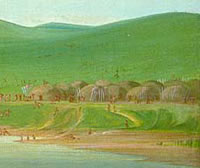
"Arikara Village of Earth-covered
Lodges, 1600 Miles above St. Louis," by George
Catlin, 1832. The Arikara are the northernmost of the
groups who spoke one of the Caddoan languages. Today
they share a reservation with the Sioux-speaking Mandan
and Hidatsa in North Dakota.
Click images to enlarge
|
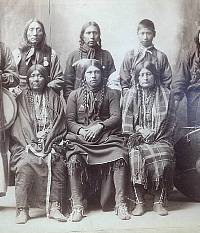
John Tatum, a Wichita man, and six
others, (on the left is Nasutoeas,a Kitsai woman), ca.
1898. Photograph by F. A. Rinehart, courtesy Omaha Public
Library..
|
|
Throughout the Tejas exhibits we use the term "Caddo"
to refer only to the Caddo speakers, their language,
and their direct ancestors and … "Caddoan"
only in the linguistic sense to refer to the Caddoan
language family.
|
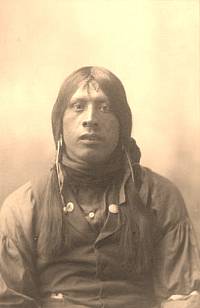
Fred Carruth, a young Wichita man,
ca. 1898. Photograph by F. A. Rinehart, courtesy Omaha
Public Library.
|
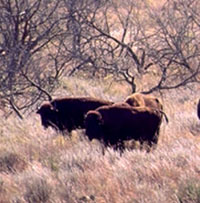
All of the Plains Caddoan groups
depended on bison herds for food, clothing, and tools.
The Pawnee, in particular, were famed bison hunters.
Courtesy Texas Parks and Wildlife Department.
|
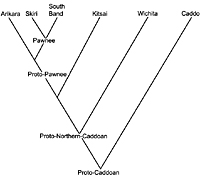
This diagram shows the relationships
among the various Caddoan languages and indicates the
order in which the various language groups are thought
to have split from one another. How long ago the various
splits occurred is very poorly known. Linguistic estimates
suggest that, prior to about 3,500 years ago, the ancestors
of all of the groups were a single people who spoke
an ancestral language that linguists call Proto-Caddoan.
About 3,500 years ago (1500 B.C.) the ancestors of the
Northern Caddoan groups split from the Caddo and the
two languages began to diversify. (Some archeologists
think the initial split may have occurred thousands
of years earlier.) Sometime after the time of Christ,
the Proto-Northern-Caddoan speakers began splitting
off, first the Wichita, then the Kitsai, and finally
the Pawnee. Still later (not long before Europeans arrived)
the Arikara split from the Pawnee and Pawnee split into
two groups.
|
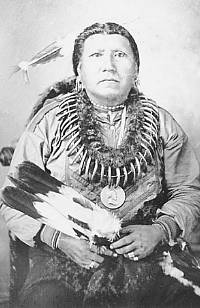
Pawnee Chief Boss Sun wearing bear
claw necklace, peace medal, and holding feather fan.
Late 19th century. Smithsonian Institution National
Anthropological Archives.
|
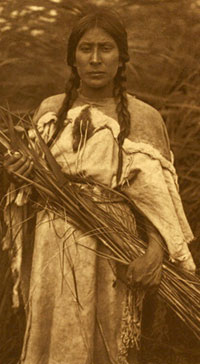
"The Rush Gatherer," an
Arikira woman, ca. 1908. Photograph by Edward S. Curtis,
The North American Indian, Volume 5. The Arikara
were the last of the Caddoan language groups to develop,
they split apart from their close relatives, the Pawnee,
about 400-500 years ago.
|
|
|
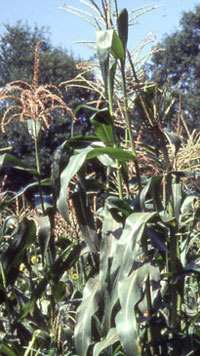
All Caddoan groups were corn farmers
to varying degrees. Corn was more important to the Caddo
in large part because climatic conditions in the Caddo
Homeland was much more favorable to growing corn than
it was on the central Plains were the Pawnee and Arikara
lived. Photograph by Frank Schambach.
|
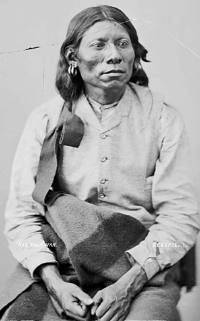
Kitsai Chief Knee-War-War in partial
native dress with ornaments, 1872. Smithsonian Institution
National Anthropological Archive.
|
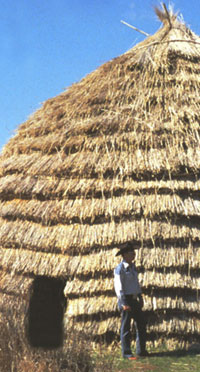
Wichita grass house on display at
Indian City, Anadarko, Oklahoma. Photograph courtesy
Dee Ann Story.
|
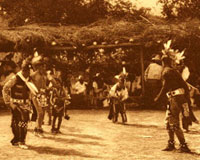
Wichita grass-house ceremony, ca.
1927. Photograph by Edward S. Curtis, The North American
Indian, Volume 19.
|
|
